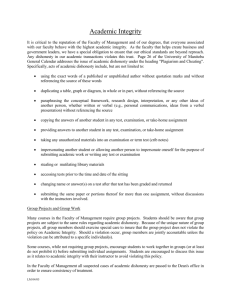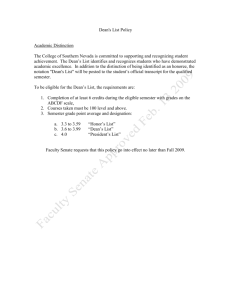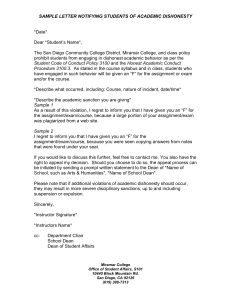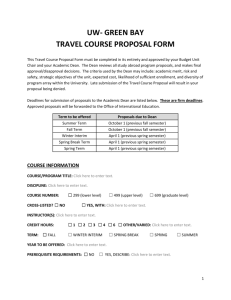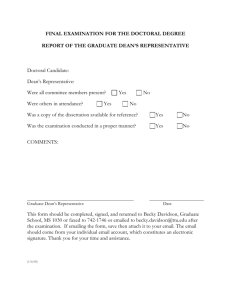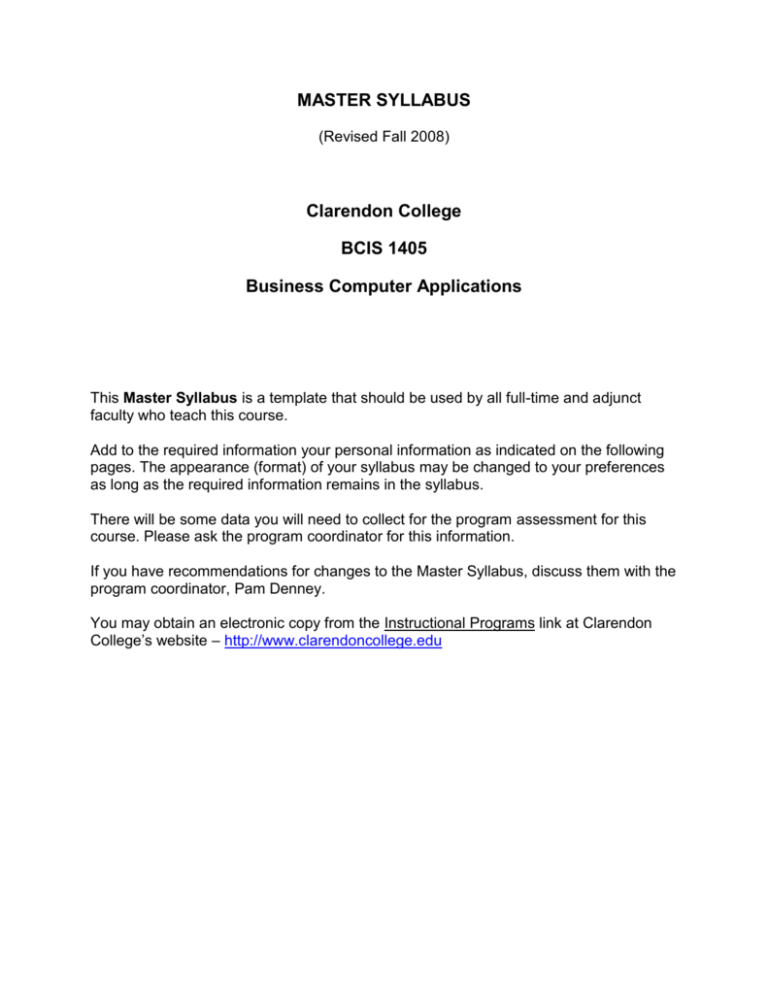
MASTER SYLLABUS
(Revised Fall 2008)
Clarendon College
BCIS 1405
Business Computer Applications
This Master Syllabus is a template that should be used by all full-time and adjunct
faculty who teach this course.
Add to the required information your personal information as indicated on the following
pages. The appearance (format) of your syllabus may be changed to your preferences
as long as the required information remains in the syllabus.
There will be some data you will need to collect for the program assessment for this
course. Please ask the program coordinator for this information.
If you have recommendations for changes to the Master Syllabus, discuss them with the
program coordinator, Pam Denney.
You may obtain an electronic copy from the Instructional Programs link at Clarendon
College’s website – http://www.clarendoncollege.edu
SYLLABUS
CLARENDON COLLEGE
Division of Business and Technology
Course Name: BCIS 1405 Business Computer Applications
Credit Hours: 4
Semester:
Classroom Location:
Instructor:
Office Location:
Phone:
Email:
Fax:
Other:
Office Hours:
Comment: Adjunct faculty should post one hour per week for each course taught,
Example: thirty minutes before and thirty minutes after class
Course Description:
Computer terminology, hardware, software, operating systems, and information systems relating to the
business environment. The main focus of this course is on business applications of software, including
word processing, spreadsheets, databases, presentation graphics, and business-oriented utilization of the
Internet.
Statement of Purpose:
This course satisfies the computer literacy component of the core curriculum and partially satisfies the
requirements for the Associate in Arts degree for students majoring in Business Administration or
Computer Information Science and is designed for transfer to a senior college or university.
Required Instructional Materials:
Course Textbook
Grauer, Exploring Microsoft Office 2007, Volume I, Pearson - Prentice Hall, 2008. ISBN: #
013157643
Other Relevant Materials:
Comment: List any relevant materials students need if they are to be successful in the course (i.e. writing
paper, pens, pencils, dictionary, thesaurus, etc.).
Student Requirements
Comment: List any particular requirements you have of the students if they are to be successful in the
course.
Methods of Instruction
Comment: List all instructional delivery types that you will plan on using (i.e. Lecture, videotape,
demonstrations, presentations, peer review, readings, internet, e-mail, chat, etc.)
Course Purposes:
Improve your ability and increase your desire to acquire new computer-related skills and knowledge.
Improve your personal productivity skills through the use of operating system, word processing,
spreadsheet, and database software.
Improve your communication skills through in-class discussions, team projects, oral presentations, and
email.
Improve your research skills through the use of the Internet to locate information resources.
Increase your knowledge of the ways the internet and application software are used in a business
environment.
Comment: The following are the minimum objectives you must include in your syllabus. You may add
others as desired.
Course Objectives:
As a result of this course, you should be able to meet the objectives and learning outcomes listed below.
(You should expect to meet these outcomes only if you honor all course policies, attend classes regularly,
complete all assigned work in good faith and on time, and meet all other course expectations of you as a
student).
Objective: Utilize appropriate computer-based technology to interpret, model and solve contemporary
real-world problems.
Learning Outcomes:
Use appropriate computer programs to solve contemporary real-world problems.
Integrate appropriate features from several commonly used application programs to generate
a document (or set of documents) that solves a contemporary real-world problem.
Identify the best methods for safeguarding a computer system from current security threats.
Support your views about ethical computer activities.
Objective: Understand and apply basic principles of critical thinking, problem solving, and technical
proficiency in solving problems.
Learning Outcomes:
Demonstrate proper file management techniques to manipulate files and folders in a
networked environment.
Apply proper formatting techniques to a document draft so that it models a previously
formatted document.
Develop an algorithm that solves a problem.
Objective: Understand and demonstrate oral and visual communication through technology using
invention, evaluation, organization, drafting, revision, editing, and presentation.
Learning Outcomes:
Demonstrate the effective use of search engines to find reliable and relevant internet
resources.
Evaluate, organize, draft, revise, and edit information in a timely manner.
Demonstrate effective oral presentation skills using a slideshow (created with a presentation
graphics program) as a visual aid.
Required Lab
A weekly lab is required and is the reason this course is a 4 credit hour course instead of
the typical 3 credit hours for a straight lecture course. There will be 10-11 weekly labs
followed by a comprehensive lab exam. You will be given lab assignments to complete during
each of these lab sessions. You will remain for the entire lab session unless you complete
your lab assignment before the lab session is over. You are to work only on the lab
assignment during the lab session. The lab session is designed to take the average person
the whole lab time period. (It is not a time to check email, surf the internet, or work on other
homework!) If for some reason you cannot complete the lab during the assigned lab session,
the lab instructor may allow you to remain longer to complete it or attend one of the other lab
sessions during that week to complete it. If you have been spending lab time on other
projects besides the lab, the lab instructor has the right to ask you to turn in the work you
have completed and not be allowed to complete the lab.
Comment: You may request the lab assignments being used currently from the program
coordinator. If you choose to create your own labs, there should be at least 9 lab
assignments given over the course in which it should take the average student at least 2
hours to complete. At least one of the lab assignments must include integration activities with
at least three of the MS Office products. A skills pretest should be conducted during the first
lab and a skills posttest should be conducted during the final lab. The pretest and posttest are
available from the program coordinator.
Course Project
Comment: The course project should count as 10% - 15% of the total course grade.
A major portion of your final grade will be obtained through your completion of a Course Project. You will
work on this project at different times during this course. The final stage of the project will be for you to
deliver a speech in front of your classmates, using a PowerPoint slideshow you have developed as a
visual aid.
The main objective of the Course Project is for you to learn to plan, organize, draft, revise, edit, and
complete a large project on time. Generally in order for a large project to be completed by a specified
deadline in the “real work world,” a timeline is given that designates when certain parts of the project need
to be completed so you can successfully meet the final deadline for the entire project.
In this course, you will have four deadlines to meet for this project. Below is a general description of each
of the four phases of the project. A due date for each phase is given on your Course Schedule. You will
receive specific instructions for each phase of the project as you proceed through the course.
Submit topic for approva
Phase 1–Research your topic on the internet and find at least two websites with information. Find
statistics that deal with your topic, and find multimedia objects (images, sounds, video, etc.) on
the internet that can be used when you develop your slideshow.
Phase 2 – Organize your speech by using MS Word to create an outline of the major points you
plan to cover in your speech. You will also type a draft of your project speech using MLA
formatting guidelines.
Phase 3 –Use MS Excel to create a chart with the statistics you plan to use in your presentation
slideshow. Complete the skeleton of your PowerPoint slideshow.
Phase 4 – Complete your PowerPoint slideshow using your outline and written speech as guides.
Use your slideshow as a visual aid as you deliver a speech about your topic in front of your class.
You will also create a narrated version of your slideshow that could be shared with family or
friends.
The grade for the Course Project is determined as follows:
Topic.......................................................................5 pts. possible
Phase 1 ..................................................................10 pts. possible
Phase 2 ..................................................................10 pts. possible
Phase 3 ..................................................................10 pts. possible
Phase 4 ..................................................................65 pts. possible
(You will receive a grade of zero on the entire project if you do not deliver the speech.)
Grading Policies:
Comment: This is where you break down how your course will be graded. All academic courses are
required to have a final exam or its equivalent. A final exam and any other tests must account for at least
50% of the final grade. Graded assignments such as labs must account for at least 25% of the final
grade.
Faculty should follow the grading scale stated in the college catalog.
The final semester grades will be figured as set in the current catalog:
90 to 100 = A
80 to 89 = B
70 to 79 = C
60 to 69 = D
Below 59 = F
A student’s final grade will be made available through Campus Connect at Clarendon College’s website.
Classroom Policies:
Comment: List the following current Clarendon College classroom policies. You should also list all of your
personal classroom policies regarding such things as academic integrity incidents (cheating, plagiarism,
or other dishonest acts), attendance, late assignment(s), missed examination(s), safety, collaborative
work, extra credit, etc.
Academic Integrity and Dishonest Behavior.
Clarendon College is committed to a philosophy of honesty and academic integrity. It is the responsibility
of all members of the Clarendon College community to maintain academic integrity at Clarendon College
by refusing to participate in or tolerate academic dishonesty. Any act of academic dishonesty will be
regarded by the faculty and administration as a serious offense.
Academic dishonesty violations include, but are not limited to: (1) obtaining an examination , classroom
activity, or laboratory exercise by stealing or collusion; (2) discovering the content of an examination ,
classroom activity, laboratory exercise, or homework assignment before it is given; (3) observing the
work of another during an examination or providing answers to another during the course of an
examination; (4) using an unauthorized source of information during an examination , classroom activity,
laboratory exercise, or homework assignment ; (5) entering an office, classroom, laboratory, or building to
obtain unfair advantage; (6) taking an examination for another person; (7) completing a classroom
activity, laboratory exercise, homework assignment, or research paper for another person; (8) altering
grade records; (9) using any unauthorized form of an electronic communication device during an
examination, classroom activity, or laboratory exercise; and/or, (10) plagiarism. (Plagiarism is defined as
the using, stating, offering, or reporting as one’s own, an idea, expression, or production of another
person’s work without proper credit. This includes, but is not limited to, turning in a paper purchased or
acquired from any source, written by someone other than the student claiming credit, or stolen from
another student.)
Students are responsible for reporting known acts of academic dishonesty to a faculty member, the
program coordinator, the associate dean, and/or dean. Any student with knowledge of a violation who
fails to report it shall him/herself be in violation and shall be considered to have committed an act of
academic dishonesty. Additionally, any student who reports him/herself in violation of this code before it is
likely that another might consider this possibility will be understood as repentant and acting in good faith.
Though the confession will not excuse the student for the violation, the confession will be considered and
the violation should not result in suspension from school except in the most extreme cases.
While academic integrity and honesty are the responsibility of the individual student, each individual
faculty member, teaching assistant, and/or laboratory instructor is responsible for classroom management
and for maintaining ethical behavior within the classroom and/or laboratory. Faculty who discover or
suspect a violation should discuss the matter with the suspected violator(s) and attempt to resolve the
case at that point. In cases of convincing evidence, the faculty member should take appropriate action.
The faculty member and student should complete a Counseling Sheet regarding the violation. (The
Counseling Sheet should contain at a minimum the date and time of the violation, the course, the
instructor’s name, the student’s name, an explanation of the infraction or facts of the case, and the
resolution to the incident.) This form should be signed by the student, faculty member, program
coordinator, and the Dean of Students. The Dean of Students will maintain a file on all violations. If a
faculty member prefers to report the case directly to the Dean of Students, it remains his/her prerogative
to do so. Additionally, if the faculty member and the accused student cannot reach a resolution or if the
faculty member believes that suspension from school is the only fair sanction, the case should
immediately be reported by the faculty member, in writing, to the Dean of Students. If the Dean of
Students observes any trends in student behavior which involve more than one violation or act of
academic dishonesty, the Dean is responsible for notifying all faculty members involved, for contacting
the student(s) involved, and after consultation with the faculty member(s) involved for taking the
appropriate action. The Dean of Students is responsible for the timely notification (normally within two
weeks) to all parties of an action taken.
Students wishing to appeal a disciplinary decision involving academic integrity or acts of academic
dishonesty may do so through the Student appeals and Grievance Procedure.
American with Disabilities Act Statement:
Clarendon College provides reasonable accommodations for persons with temporary or permanent
disabilities. Should you require special accommodations, notify the Office of Student Services (806-8743571 or 800-687- 9737). We will work with you to make whatever accommodations we need to make.
Dropping a Course:
A student who is enrolled in a developmental course for TSI purposes may not drop his/her only
developmental course unless the student completely withdraws from the college. A student may drop any
other course with a grade of “W” any time after the census date for the semester and on or before the end
of the 12th week of a long semester, or on or before the last ay to drop a class of a term as designated in
the college calendar. The request for permission to drop a course is initiated by the student by procuring
a drop form from the Office of Student Services. (Refer to other policies concerning this issue in the
current college catalog online.)
According to Texas state law a student is only allowed to drop the same class twice before he/she will be
charged triple the tuition amount for taking the class a third time or more. Furthermore, beginning with
the Fall 2007 semester, students in Texas may only drop a total of 6 courses throughout their entire
undergraduate career. After the 6th dropped class, he/she will no longer be able to withdraw from any
classes.
Withdrawal from College:
When a student finds it necessary to withdraw from school before the end of the semester, he or she
should obtain a withdrawal form from the Office of Student Services. Students may also withdraw from the
college by sending a written request for such action to the Registrar’s Office. The request must include
the student’s signature, the student’s current address, social security number and course information
details. Students who withdraw after the census date for the semester and on or before the end of the 12th
week of a long semester, or on or before the last day to drop a class of a term as designated in the
college calendar will be assigned a grade of “W.”
Tentative Course Schedule/Outline:


